
The Texas horned lizard is one of about 21 North American species of spikey-bodied reptiles called horned lizards, all belonging the genus Phrynosoma. It occurs in south-central regions of the US and northeastern Mexico, as well as several isolated introduced records and populations from Southern United States. Though some populations are stable, severe population declines have occurred in many areas of Texas and Oklahoma. The Texas spiny lizard may be confused for a Texas horned lizard due to its appearance and overlapping habitat.
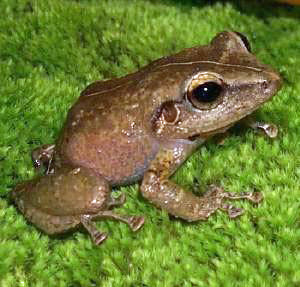
The common coquí, widely known as the coquí, is a species of frog native to Puerto Rico belonging to the family Eleutherodactylidae. The species is named for the loud call the males make at night, which serves two purposes; the "co" serves to repel other males and establish territory while the "quí" serves to attract females. The auditory systems of males and females respond preferentially to different notes of the male call, displaying sex difference in a sensory system. The common coquí is a very important aspect of Puerto Rican culture, and it has become an unofficial territorial symbol of Puerto Rico. The frog is also found elsewhere, and is usually considered an invasive species outside Puerto Rico.

The golden coquí is a rare, possibly extinct species of frog endemic to Puerto Rico.
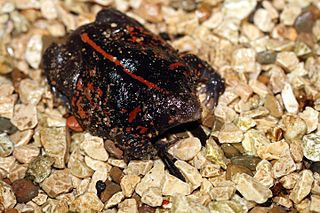
The Mexican burrowing toad is the single living representative of the family Rhinophrynidae. It is a unique species in its taxonomy and morphology, with special adaptations to assist them in digging burrows where they spend most of their time. These adaptations include a small pointed snout and face, keratinized structures and a lack of webbing on front limbs, and specialized tongue morphology to assist in feeding on ants and termites underground. The body is nearly equal in width and length. It is a dark brown to black color with a red-orange stripe on its back along with splotches of color on its body. The generic name Rhinophrynus means 'nose-toad', from rhino- (ῥῑνο-), the combining form of the Ancient Greek rhis and phrunē.
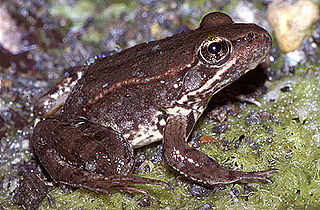
The California red-legged frog is a species of frog found in California (USA) and northern Baja California (Mexico). It was formerly considered a subspecies of the northern red-legged frog. The frog is an IUCN near-threatened species as of 2021, has a NatureServe conservation status of Imperiled as of 2015, and is a federally listed threatened species of the United States that is protected by law.
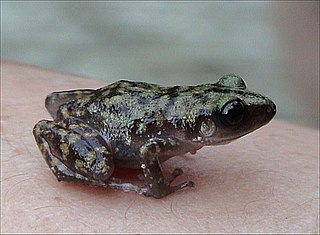
Eleutherodactylus marnockii, the cliff chirping frog, is a small eleutherodactylid frog found in Central and West Texas, United States, and in Coahuila and Chihuahua, northern Mexico. It is also known as the cliff frog and Marnock's frog.

The northern sheep frog is native to Central America, Mexico, and extreme south Texas, United States. It occurs in the lowlands from Sonora, Mexico, to northern Costa Rica on the Pacific coast, and south Texas to Honduras on the Gulf of Mexico and Caribbean coasts. The sheep frog inhabits semiarid thornscrub, savannas, pasturelands, and open woodlands, as well as more humid, moist forest in the canyons, basins, foothills, and lower elevations of mountains slopes. It is a fossorial, burrowing frog that is seldom seen on the surface except at night after heavy rains when they emerge to breed. The sheep frog gets its name from its distinctive call that resembles a sheep's bleat. It is a diet specialist primarily feeding on termites and ants.

Notophthalmus meridionalis, the black-spotted newt or Texas newt, is a species of aquatic newt native to northeastern Mexico and southern Texas in the United States. This amphibian was put on the IUCN Red List of Endangered Species in 2008 with populations still decreasing. It was reclassified to Vulnerable in 2022.

Eleutherodactylus cystignathoides, also known as the Rio Grande chirping frog, Mexican chirping frog, or lowland chirping frog, is a small eleutherodactylid frog. It is found from the southern United States in Texas, and in the northeastern Mexico in the states of Nuevo León, Tamaulipas, San Luis Potosí, Hidalgo, and Veracruz. Its range in Texas has expanded because of transport in potted plants, and has been reported in Northern Louisiana in Caddo Parish.

The crawfish frog is a medium-sized species of frog native to the prairies and grasslands of the central United States. It gets its name because it inhabits the burrows of crayfish for most of the year. They have defined golden or black circles all over their body.

Atelopus chiriquiensis, the Chiriqui harlequin frog or Lewis' stubfoot toad, is an extinct species of toad in the family Bufonidae that was found in the Cordillera de Talamanca in Costa Rica and western Panama. Its natural habitats were stream margins in lower montane wet forests and rainforests. Its elevational range was 1,400–2,500 m (4,600–8,200 ft) asl.
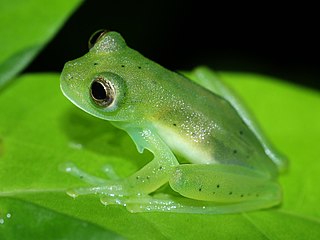
The Andes giant glass frog is a species of frog in the family Centrolenidae. It is found in the Cordillera Oriental of Colombia and the Mérida Andes and Serranía del Perijá of Venezuela.
Sarcohyla cembra, also known as the Southern Sierra Madre treefrog, is a species of frog in the family Hylidae. It is endemic to Mexico. Until recently, it was only known from two male specimens: one from its type locality on the Pacific slopes of the Sierra Madre del Sur mountains, Pochutla District, Oaxaca, and another one from Sierra de Yucuyacua south-east of Llano de Guadalupe, in north-west Oaxaca. The two locations are about 172 km (107 mi) apart. After having not been seen after 1993, it was feared that the species might be extinct. However, the species was rediscovered in field surveys in 2011–2012, extending its range with a new locality about 10 km north of the type locality.
The La Selle red-legged frog or Furcy robber frog is a species of frog in the family Eleutherodactylidae. It is endemic to southern Hispaniola and occurs in both Haiti and the Dominican Republic. Specifically, it occurs on the Massif de la Selle (Haiti) to the western Baoruco Mountain Range. Its natural habitat is upland mesic pine forest, where it is usually found under rocks and logs. It is threatened by habitat loss caused by logging and agriculture. It is known from protected areas, but habitat loss continues also within those areas.

Eleutherodactylus longipes is a species of frog in the family Eleutherodactylidae. It is endemic to Mexico and occurs on the Sierra Madre Oriental between central Nuevo León and adjacent Coahuila in the north and northern Hidalgo in the south. It is also known as the long-footed chirping frog and longfoot robber frog, among other names.
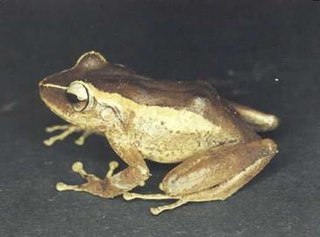
Eleutherodactylus portoricensis is a frog native to Puerto Rico that belongs to the family Eleutherodactylidae. Its vernacular English names are upland coqui, mountain coqui, and Puerto Rican robber frog. The species’ range spans the Luquillo Mountains of northeastern Puerto Rico and the Cordillera Central, which forms the highland “backbone” of Puerto Rico and includes an eastern extension beginning at the city of Cayey. However, the species is likely extirpated from the western Cordillera Central.
Eleutherodactylus rufescens, commonly known as the red peeping frog or Nevado de Colima chirping frog, is a species of frog in the family Eleutherodactylidae. It is endemic to Mexico and known from the region of the eponymous Nevado de Colima mountain in Colima, Jalisco, and further east and south in the Jalisco and Michoacán states. Its natural habitat is subtropical or tropical moist montane forests. It is threatened by habitat loss.
Eleutherodactylus diplasius, the patternless whistling frog, is a species of frog in the family Eleutherodactylidae. A native of Haiti, it can be found in the Tiburon Peninsula northwest, to the Massif de la Hotte. It has an estimated polygon range of ca. 814 km2, spanning an elevational range of 0–1,207 m asl. In July 2011 it was found in at Morne Deux Mamelles.















